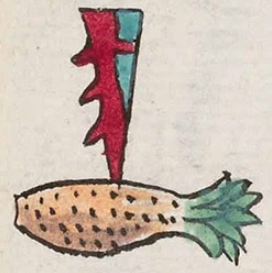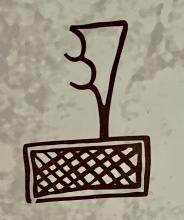Huitzamollan (Mdz39r)
This compound glyph for the place name Huitzamolla includes a thorn (huitztli) and what appears to be a root of a plant (amolli) that produces a soapy substance. The locative suffix (-tlan), which becomes -lan before a stem ending in the letter l, such as amol-, is not shown visually, but the gloss supports its reading. The multi-colored huitztli is upright, with the sharp point down. It is painted red and turquoise blue, and has a jagged edge. The root of the amolli is horizontal and rounded, with the exception of the end on the viewer’s right being spiky, something like the top of a pineapple.
Stephanie Wood
The huitztli probably comes from the tip of a maguey leaf. It looks much like other spines or thorns in the Codex Mendoza. Because these spines were used for self-sacrificial blood-letting, the red color may suggest blood.
Stephanie Wood
huitzamola.puo
Huitzamollan, pueblo
Stephanie Wood
c. 1541, but by 1553 at the latest
Stephanie Wood
There could be sand added to the plant root, which would make a third element.
blood, sacrifice, offerings, thorns, spines, soap plants, espinas, sangre, ofrendas, nombres de lugares
This reproduction of a compound hieroglyph in the mural museum at Classic-Period Teotihuacan has an arrangement something like this glyph for Huitzamollan. It is unknown whether Nahuatl was the language of the writing system at Teotihuacan, but this is a similar construction as found Nahuatl compounds of the Post-Classic period. See Quetzalayatl for a similar rectangle with a mesh pattern. If not an ayatl, that rectangle could be a tilmatli. Photo by S. Wood, 6 May 2025.

huitz(tli), thorn or spine, https://nahuatl.wired-humanities.org/content/huitztli
amol(li), soap plant, https://nahuatl.wired-humanities.org/content/amolli
-tla (locative suffix), place of abundance of item, https://nahuatl.wired-humanities.org/content/tla-a
“Place of Thorny Amolli Roots” (she notes that the locative does not include the final “n,” so it may be a place of abundance of these roots if the missing “n” was not inadvertent; she also sees the dots on the roots as suggesting a sandy soil in which it grows. [Frances Karttunen, unpublished manuscript, used here with her permission.]
“Where Huitzamolli Abounds” (Berdan and Anawalt, 1992, vol. 1, p. 189)
Codex Mendoza, folio 39 recto, https://digital.bodleian.ox.ac.uk/objects/2fea788e-2aa2-4f08-b6d9-648c00..., image 88 of 188.
Original manuscript is held by the Bodleian Libraries, University of Oxford, MS. Arch. Selden. A. 1; used here with the UK Creative Commons, “Attribution-NonCommercial-ShareAlike 3.0 License” (CC-BY-NC-SA 3.0)



